

The Magic of Miyadaiku
|
With over 150,000 temples and shrines in Japan, considerable effort and techniques are necessary to maintain them. The craftsmen who specialise in building and restoring these buildings are known as miyadaiku. The oldest organisation made up of these carpenters is Kongo Gumi Co., Ltd., located in Osaka and believed to have been originated with the construction of Shitennoji Temple in 593. Shitennoji Temple happens to be the first official Buddhist temple in Japan. Since then, numerous temples and shrines utilising these specialised techniques have been built across Japan. These include World Heritage sites or national treasures.
Among the different traditional techniques, an important one is kigumi, a method of joining wood without using nails or metal fittings, hence creating a sturdy three-dimensional framework. This joinery method is adapted to Japan’s climate of humid summers and dry winters, as well as frequent earthquakes. It allows the wooden joints to absorb and disperse vibration while maintaining the structural integrity, and thus translating into a greater tolerance for withstanding earthquakes. It also makes the wood less susceptible to damage by corroded metal when they inevitably rust. Instead, the wood can absorb moisture when it is humid, and expel it when it is dry. There is also an abundance of wood in Japan, so this method is suitable for dismantling and repairing or relocating a building, or replacing rotten wood. As a result, the buildings can exist for hundreds or thousands of years. There are two main techniques in joining wood: tsugite and shiguchi. The former is splicing two pieces of wood together to form a long pillar or beam. The latter is interlocking pillars and beams at angles. There are over 200 types of kigumi techniques, in which the wood is shaved according to the shape and strength of the wood as well as the final design structure. The pieces are fitted tightly together, but still with a gap small enough to absorb and disperse vibrations from earthquakes and typhoons. It is required for miyadaiku to go through years of training, while learning under a veteran and observing their skills up close. They need to have knowledge of the characteristics of each wood, as well as fully grasp the precise cutting techniques. Since most of the architecture are buildings that houses Buddhas and gods, miyadaiku must also understand the culture and religion. While there used to be the concern of fire outbreaks, recent developments in technology and engineering have produced wooden materials that are fire resistant. Thus, we can see the same joinery techniques being employed in modern architecture. For example, renowned Japanese architect Kengo Kuma used it in the Sunny Hills shop in Aomaya, Tokyo, the Yusuhara Wooden Bridge Museum in Kochi, as well as the GC Prostho Museum Research Centre in Aichi. Similar influences can also be seen in the new National Stadium that was used for the 2020 Tokyo Olympics and Paralympics. UNESCO designated numerous traditional skills, techniques, and knowledge for wooden Japanese architecture as Intangible Cultural Heritage in 2020, which included wooden joinery. Without a doubt, the work of miyadaiku is admirable and just like how they preserve historical buildings for many years, we hope to see their techniques and spirit continue for generations to come. |
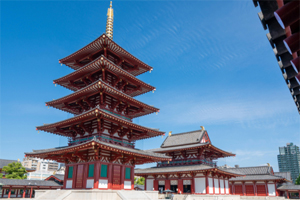 Shitennoji Temple © Web Japan 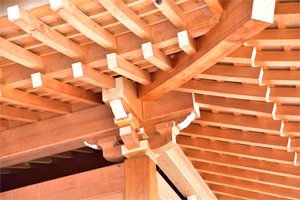 © Japan Up Close 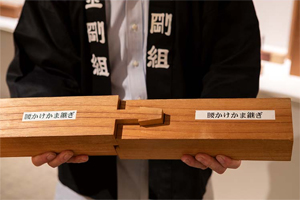 Tsugite © Kawabe Akinobu 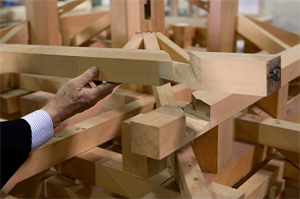 Shiguchi © Kawabe Akinobu 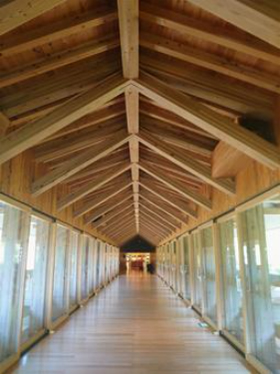 Yusuhara Wooden Bridge Museum © photoAC |
Resources
|
“Traditional Japanese woodworking technique “Kumiki””. 2023. Japan Up Close. https://japanupclose.web-japan.org/techculture/c20230728_1.html. “Traditional Building Techniques Passed Down Through The Ages”. 2022. niponica. https://web-japan.org/niponica/niponica32/en/feature/feature02.html. “Kigumi 木組み: Japanese Joinery”. 2024. Japan Information & Cultural Center. Accessed 16 August. https://www.us.emb-japan.go.jp/jicc/exhibits/tokyo-evolution-kigumi.html. “The Secret of Japan’s Carpenters: How ‘Miyadaiku’ Techniques Construct Timeless Temples Without Nails”. 2023. LIVE JAPAN. https://livejapan.com/en/in-kansai/in-pref-osaka/in-osaka-suburbs/article-a2000907/. Sakazaki, Nao. 2020. “A Close Look At the Master Craftsmanship of Japan’s Temples & Shrine Carpenters! Discover the Amazing Traditional Japanese Technique of Building Without Using Nails”. COOL JAPAN VIDEOS. https://cooljapan-videos.com/en/articles/9hwa5hdx. |
|
Japan Creative Centre 4 Nassim Road, Singapore 258372 +65 6737 0434 / jcc@sn.mofa.go.jp https://www.sg.emb-japan.go.jp/JCC/ Nearest parking at Orchard Hotel & Delphi Orchard |
 |